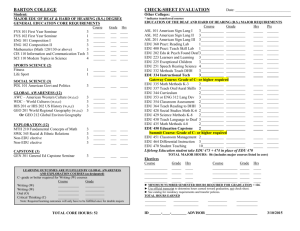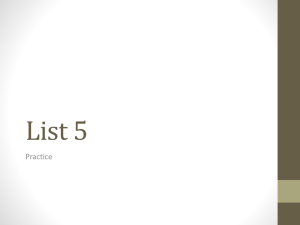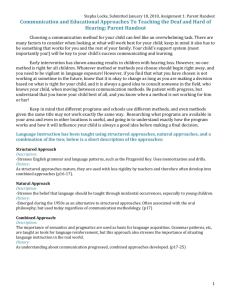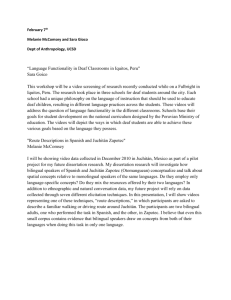File - ASL-English Bilingual Practices
advertisement
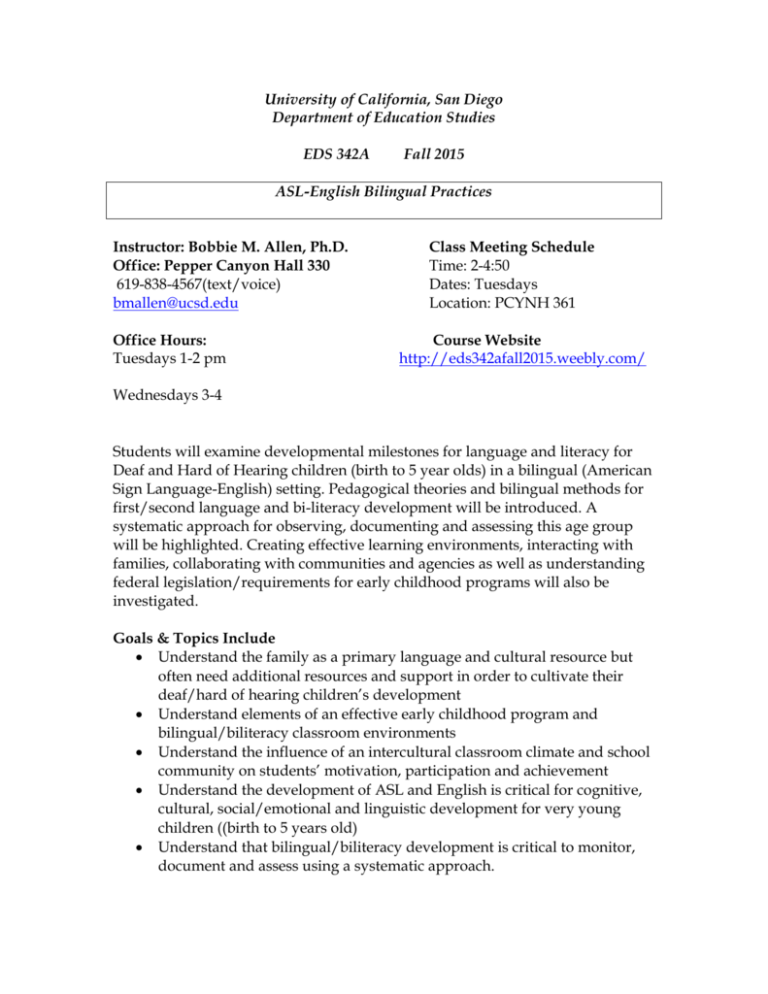
University of California, San Diego Department of Education Studies EDS 342A Fall 2015 ASL-English Bilingual Practices Instructor: Bobbie M. Allen, Ph.D. Office: Pepper Canyon Hall 330 619-838-4567(text/voice) bmallen@ucsd.edu Office Hours: Tuesdays 1-2 pm Class Meeting Schedule Time: 2-4:50 Dates: Tuesdays Location: PCYNH 361 Course Website http://eds342afall2015.weebly.com/ Wednesdays 3-4 Students will examine developmental milestones for language and literacy for Deaf and Hard of Hearing children (birth to 5 year olds) in a bilingual (American Sign Language-English) setting. Pedagogical theories and bilingual methods for first/second language and bi-literacy development will be introduced. A systematic approach for observing, documenting and assessing this age group will be highlighted. Creating effective learning environments, interacting with families, collaborating with communities and agencies as well as understanding federal legislation/requirements for early childhood programs will also be investigated. Goals & Topics Include Understand the family as a primary language and cultural resource but often need additional resources and support in order to cultivate their deaf/hard of hearing children’s development Understand elements of an effective early childhood program and bilingual/biliteracy classroom environments Understand the influence of an intercultural classroom climate and school community on students’ motivation, participation and achievement Understand the development of ASL and English is critical for cognitive, cultural, social/emotional and linguistic development for very young children ((birth to 5 years old) Understand that bilingual/biliteracy development is critical to monitor, document and assess using a systematic approach. Understand that the implementation of authentic assessment is crucial in determining next steps for students and informing our own teaching practice Understand biliteracy/Deaf cultural & visually oriented teaching practices provide opportunities for deaf and hard of children to become fluent signers, readers and writers. Understand fluency in ASL provides access to English for deaf and hard of hearing children. Understand the differences between Individual Family Plans (IFSP) and Individual Education Plan (IEP) as well as legal requirements for these plans. Dates of reading assignments are for the dates of class discussion topics. Students are required to have read and prepared for the readings prior to class meeting in order to participate in class discussion. There are on-line readings on my course webpage http://eds342afall2015.weebly.com/ UCSD Reserves Password BA342A (not case sensitive) Required Textbooks Textbooks Barr, M.A., Craig, D.A., Fisette, D., & Syverson, M.A. (1999. Assessing literacy with the Learning Record: A handbook for teachers, grades k-6. Portsmouth, NH: Heinemann Livingston, S. (1997). Rethinking the education of deaf students. Portsmouth, NH: Heinemann. Schleper, David R. (2006) Literacy—It All Connects. Washington DC: Laurent Clerc National Deaf Education Center On Line Readings on Course Website http://eds342afall.weebly.com/ and UCSD’s electronic reserves BA342A Course Expectations/Evaluation DUE POINTS Attendance & Participation: Students are expected to attend all class meetings (face to face and on-line), and arrive on time and prepared to participate in activities, including in class activities, writing assignments, and field trips. Participation in class is also considered when awarding final grades. Unexcused absences and tardiness can affect your final course grade. Project #1 Two (2) Individual Profiles with completed Learning Record Portfolio forms (see handout) Sample observations for the Learning Record due in class Bring to class to review & get feedback Talking & Listening Observations (1 per Learning Record student) Reading Observations (1 per Learning Record student) 20 3-2-1 Writing assignments due at noon the day of class— Due Dates: October 6, October 20, October 27, November 3, November 17 Upload to turnitin.com Completed (2) Individual Profiles December 8th no later than 5 pm Hardcopy, typed and stored in a 3ring notebook with both profiles November 3 Hardcopy of Data Collection Forms of the Learning Record 30 Writing Observations (1 per Learning Record student Project #2 Read Aloud Videotaped & Written Response December 8, turnitin.com by 5pm 30 Presentation of Thesis of Former Graduates, Power Point December 1, In class presentation 20 Total Points 100 Grade Breakdown Based on Number of Points Earned NOT Percentages 100-98 A+ 97-94 A 93-90 A89-88 B+ 87-84 B 83-80 B79-78 C+ 77-74 C 73-70 CBelow 70 D Below 60 F .Writing Assignments (3-2-1 Response format below) These responses to the readings are used in class to generate class discussions about what was learned that is important to your development as a bilingual teacher. Sometimes we engage in discussions about topics that may be controversial. Debates and differences of opinions are accepted,respected and encouraged. We encourage your active participation. You should follow the following format Write a 3-2-1 response to the readings 1-3 pages— 3 Big Ideas with a paragraph or so for each idea demonstrating a critical analysis and/or an argument in favor or opposing the idea 2 Question you have about the readings and would like to discuss in class 1 Choose one of the following 1. A discussion of an application for the classroom you find interesting and may want to try OR 2. A personal experience/observation and your opinion of why this experience/observation is connected to the readings OR 3. A connection to other readings/lectures/media outside this course with a brief explanation of how the connections apply to the field of Deaf Education or the classroom Submitted to Turnitin.com by due noon on due date (see above matrix) CLASS SESSIONS Session 1, September 29 Overview of the course syllabus, projects and writing assignments. In Class: In class DVD: Booksharing the Deaf Way, Chapters 1 & 2 (20 minutes) Session 2 October 6 Perspectives in Deaf Education 3-2-1 Writing Assignment #1 due today at noon. Submit to turnitin.com In class DVD: Booksharing the Deaf Way, Chapters 3: Book Sharing Events The Standardized Visual Communication and Sign Language Checklist for Signing Children (Handout In Class) Read Text: Livingston; Chapter 1 Read On-Line Articles Humphries: Schooling in American Sign Language: A paradigm shift from a deficit model to a bilingual model in deaf education http://www.escholarship.org/uc/ucbgse_bre?volume=4;issue=1 ASL/English Bilingual Education: Models, Methods and Strategies http://issuu.com/vl2newsletter/docs/rb8eng Odyssey 2012: Nussbaum, Scott & Simms: The Why and How of an ASL/English Bimodal Program http://www.gallaudet.edu/Images/Clerc/articles/Odyssey_SPR_2012_NussbaumScottSim ms.pdf Jim Cummins (1986) Empowering Minority Students: A Framework for Intervention. Harvard Educational Review: April 1986, Vol. 56, No. 1, pp. 18-37. http://www.reading.ccsu.edu/abadiano/courses/rdg503/rubrics/cummins.pd f Cummins, The Relationship Between ASL Proficiency and English Academic Development www.gallaudet.edu/documents/cummins_asl-eng.pdf Review the video clip and be prepared to discuss. In what ways does this program reflect some of the perspectives in the readings for today? Video Clip: California School for the Deaf Fremont https://www.youtube.com/watch?t=54&v=0_6RyfFscLA ASL Morning Message https://www.youtube.com/watch?v=PIgLC5Bkff4 Session 3 October 13 Infant/toddler/Preschooler Developmental Milestones NO 3-2-1 Reading Response for this session; See activity below that should be completed prior to class and use it for discussion in class In class DVD: Booksharing the Deaf Way, Chapters 4: Translating Books into ASL Burkholder, K. (1999) Reading and American Sign Language: Strategies for Translation. Perspectives, vol. 17(3) pp.6-8 (handout in class) Reading On Line & Activity due for class today 1. Skim to become familiar with the developmental milestones for “hearing”infants, toddlers and preschoolers; Look for milestones that would possibly apply or not apply to Deaf children, and make a note of these milestones to discuss in class. California Infant/Toddler Learning and Development Foundations PDF File Go to http://www.cde.ca.gov/sp/cd/re/itfoundations.asp THEN Dowdload PDF File entitled California infant/Toddler Learning & Development Foundations Introduction V-XVII The Early Months Social and Emotional Development Language Development Cognitive Development Also California Preschool Learning Foundations, Volume 1 http://www.cde.ca.gov/sp/cd/re/documents/preschoollf.pdf Skim: Foundations for Emotional-Social Development Foundations in Language and Literacy 2. Watch sign language development of young deaf children on line. Select topics/video clips from the website menu for each group: baby 0-1, toddler 1-2 and preschoolers 3-5 http://www.handspeak.com/blog/baby/?byte=&ID=35 3. Find 3 clips for each age group (baby 0-1, toddlers 1-2 and preschoolers 3-5) that represent some of the language milestones that are identified on the Standard Visual Communication and Sign Language Checklist for Signing Children for Using this checklist, mark the milestones you found on the website for each group— baby, toddler, and preschoolers. Be prepared to share your video clips of your identified milestones with your classmates. Read On-Line Articles related to Deaf Children’s Sign Acquisition Visual Language and Visual Learning Science of Learning Center. (2011, January) Advantages of Early Visual Language, ( 2011, January) Advantages of Early Visual Language. (Research Brief No. 2) Washington, D.C: Sharon Baker http://deafchildren.org/wp-content/uploads/2014/05/ASDC-Article-VL2Advantages-of-Early-Visual-Language.pdf Visual Language and Visual Learning Science of Learning Center. (2012, June). Eye Gaze and Joint Attention (Research Brief No. 5) Washington, D.C.; Leiberman, Amy http://www.csdb.org/wp-content/uploads/2014/05/Eye-Gaze-and-JointAttention.pdf The Standard Visual Communication and Sign Language Checklist for Signing Children https://www.academia.edu/5008182/The_Standardized_Visual_Communication_and_Si gn_Language_Checklist_for_Signing_Children Weebly Meir, Language Acquisition by Deaf Children Session 4 October 20 Observing and Documenting Milestones of Infants/Toddlers/Preschoolers 3-2-1 Reading Response #2 due today. Submit to turnitin.com by noon. In class DVD: Booksharing the Deaf Way, Chapters 5: Scaffolding In Class Presentation Presentation: Emergent Bilingual Deaf Learners DVD: Observing George Text: The Learning Record Read: Text Barr, Part B Documenting Talking & Listening, Reading and Writing Appendix A: Review Learning Record Developmental Reading and Writing Scales Allen, B.M (1998) Learning Together: ASL-English Bilingual-Bicultural Early Childhood Classroom, pp.78-90. 62nd Claremont Reading Conference, Claremont, CA: Claremont Graduate University. Erting & Pfau Becoming Bilingual: Facilitating English Literacy Development Using ASL in Preschool. Sharing Ideas, Washington, D.C.: Precollege National Mission Programs, Gallaudet University http://files.eric.ed.gov/fulltext/ED475322.pdf or go to Weebly Session 4 Herzig, M. Odyssey 2015 Bilingual Storybook Apps: An Interactive Reading Experience for Children http://www.gallaudet.edu/Documents/Clerc/Odyssey/2015_issue/ODYSSE Y_SPR2015_HerzigMalzkuhn.pdf See Baobab Shared Reading Lesson on Weebly Assessments on Weebly Drop Down Menu for “more…” ASL Scale of Development (Herzig, 2000) Nonverbal and Verbal Behaviors Observational Tool Session 5 October 27 Connecting with Families via Home-School Connections 3-2-1 Writing Assignment #3 due today at noon. Submit to turnitin.com View: Through My Child’s Eyes: American Sign Language http://www.csun.edu/~tyce/enindex.html Review Assignment Handout: The Learning Record/Individual Profile Project Read Text: Barr: pp. xi-14 Part A/C; Family Conversations Part A/C ; 15-28 & 53-56 Allen, B.M. (1998) ASL-English Classroom: The Families’ Perspectives, Bilingual Research Journal,vol.26 (1), 149-168 http://www.researchgate.net/profile/Bobbie_Allen2/publication/252682167_A SLEnglish_Bilingual_Classroom_The_Families'_Perspectives/links/53fd189f0cf2 364ccc08a15b.pdf Weebly Mahshie: A first language: Whose Choice Is It? Humphries, Kushalnagar,Mathur,Napoli, Padden, Rathmann, & Smith (2013) The Right To Language. Journal of Law, Medicine and Ethics. Session 6 November 3 Social & Learning Contexts 3-2-1 Writing Assignment #4 due today at noon. Submit to turnitin.com Due today: Bring to class the following: Your Learning Record letter to Family/Parents For each Learning Record Student bring YOUR BENCHMARKS 1 Observations for talking & listening, signing 1 Observation of reading + copy 1 page of the text 1 Observation of writing observation +copy student writing sample Read Text Livingston, Chapter 2 Gerner de Garcia,B. (2002) Meeting the Needs of Hispanic/Latino Deaf Students, in Christensen (Ed.), A Multicultural Perspective,pp.150-197 http://www.ncela.us/files/rcd/be021519/esl_applications_for_hispanic_deaf.p df _____________________________________________________________________ Observation: November 5th Thursday California School for the Deaf, Riverside Parent Infant Program (PIP) Arrive at 8:00am Observation: November 19 Davilla Day School for the Deaf, Chula Vista School District, on the campus of Vista Square, 8:30-9:30 Observation of ASL English Preschool ______________________________________________________________________ ______________________________________________________________________ Observations: Thursday, Nov 19th Davila Day School, at Vista Square Elementary Preschool Program Prior to observations, please read the following on line articles The differences between an IFSP (Individual Family Service Plan) and an IEP (Individual Education Plan) http://www.pacer.org/parent/php/PHP-c59.pdf. Best Practices for Deaf/Hard of Hearing infant/toddlers http://www.dds.ca.gov/EarlyStart/docs/BestPractices_ESInfantToddlersDeaf. pdf ____________________________________________________________________ Session 7 November 10 Making ASL English Connections In class DVD Activity: Linking ASL and English Chapter 6 Guest Speaker: Tom Humphries 3:30-4:30 Chaining Read on Weebly: Humphries & MacDougall: Chaining Andrews, Codeswitching techniques: Evidence based instructional practices for the ASL/English Classroom, American Annals of the Deaf, vol 155, Number 4, Fall 2010, pp 407-424. (Weebly) https://muse.jhu.edu/journals/american_annals_of_the_deaf/v155/155.4.andre ws.pdf Session 8 November 17 Literacy: It All Connects 3-2-1 Writing Assignment #5 due today at noon. Submit to turnitin.com Read: Schleper, David R. Literacy—It All Connects pp 4-29 Schleper: Appendix I- III Livingston: Chapter 3, pp 45-87 Session 9 November 24 NO Class Session 10 December 1 Presentations of Theses In class DVD/Activity: DVD: Book Sharing the Deaf Way Chapter 7 Book Selection and Multi-Level Grouping Due Presentations: Submit powerpoint to me via email no later than NOON today Jennifer Cole Regis: Morning Meeting as a Tool for Community-Building and Developing Literacy Skills in ASL and English Jennifer Hipskind: Fostering Deaf Identity Sheneman: Finding ASL/English Equivalencies Stone: Ka-Pow: Using ASL-English To Explore Narratives in Comics On Line Course Website The Morning Meeting Book (Jennifer Cole Regis’ thesis) Finals Week December 8 No Class Due Project 1 compiled and completed for 2 students Hardcopies of the Learning Record Forms/ Individual Learner Profiles are due by 5pm today Both students profiles should be bound in a 3-ring NOTEBOOK Include the following in this order (see handout) 1. Cover Sheet-Individual Profile Analysis and Reflection 2. Letter to Parents/Family 3. Completed Forms of LR for 2 students in the following order: Part A Literacy Conversation for student and family Summaries for B1, B2 and B3 (Place behind Part A) Observations of each student on the LR data collection forms for o Talking/Listening/ASL (3 observations) o Reading + copy of 1 page of the text (2 observations) o Writing + copy of student writing sample (2 observations) 4. ASL Scale of Development (circle characteristics and dated to match each observation for Talking, Listening, ASL.) Place ASL Scale behind the observations for “Talking/Listening. 5. IFSP/IEP/ITP goals for each student (Reading, Writing, ASL and Spoken English.. Place these goals behind writing samples. 6. Audiogram for each student ( Place behind IFSP/IEP/ITP goals)



